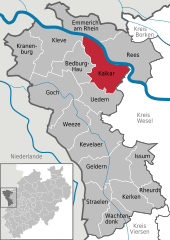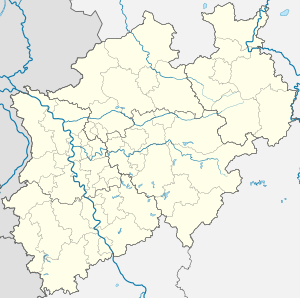Kalkar
Kalkar is a municipality in the district of Kleve, in North Rhine-Westphalia, Germany. It is located near the Rhine, approx. 10 km south-east of Cleves. The most famous building of Kalkar is its church St. Nicolai, which has one of the most significant sacral inventory from the late Middle Ages in Europe.
Kalkar | |
|---|---|
Marktplatz in Kalkar | |
 Coat of arms | |
Location of Kalkar within Kleve district   | |
 Kalkar  Kalkar | |
| Coordinates: 51°44′20″N 6°17′33″E | |
| Country | Germany |
| State | North Rhine-Westphalia |
| Admin. region | Düsseldorf |
| District | Kleve |
| Subdivisions | 13 |
| Government | |
| • Mayor | Britta Schulz |
| Area | |
| • Total | 88.2 km2 (34.1 sq mi) |
| Elevation | 14 m (46 ft) |
| Population (2018-12-31)[1] | |
| • Total | 13,902 |
| • Density | 160/km2 (410/sq mi) |
| Time zone | CET/CEST (UTC+1/+2) |
| Postal codes | 47546 |
| Dialling codes | 0 28 24 |
| Vehicle registration | KLE |
| Website | www.kalkar.de |
History
Kalkar was founded by Dirk VI of Cleves in 1230 and received city rights in 1242. It was one of the seven "capitals" of Cleves (called Kleve), until the line of the Duchy of Cleves died out in 1609, whereupon the city went over to the Margraviate of Brandenburg. Marie of Burgundy, Duchess of Cleves retired to Monreberg castle in Kalkar, where she founded a Dominican convent in 1455. Under her influence the city bloomed and artists were attracted to the favorable climate for cultural investment. She died at Monreberg castle in 1463.
Air base
The USAF 470TH Air Base Squadron supports the NATO Joint Air Power Competence Center (JAPCC) in Kalkar and the NATO CAOC in Uedem. The 470th is not located in Kalkar however.[2]
Nuclear reactor
Between 1957 and 1991, West Germany, Belgium and the Netherlands pursued an ambitious plan for a fast breeder nuclear reactor, the a 300-megawatt (400,000 hp) prototype reactor, SNR-300, near Kalkar. Construction of the SNR-300 began in April 1973. In the wake of large anti-nuclear protests at Wyhl and Brokdorf, demonstrations against the SNR-300 reactor escalated in the mid-1970s. A large demonstration in September 1977 involved a "massive police operation that included the complete closure of autobahns in northern Germany and identity checks of almost 150,000 people".[3]
_(cropped).jpg)
Construction of the Kalkar reactor was completed in the middle of 1985, but a new state government was clearly against the project, and opposition mounted following the Chernobyl disaster in April 1986. In March 1991, the German federal government said that the SNR-300 would not be put into operation; the project costs, originally estimated at $150 to $200 million, escalated to a final cost of about $4 billion (equivalent to about $8B in 2019).[3]
The nuclear reactor plant has since been turned into Kern-Wasser Wunderland, an amusement park with a rollercoaster and several other rides and restaurants.[3]
Novel
In the science fiction novel "The Moon Maid", Edgar Rice Burroughs used "Kalkars" as the name for a malevolent fictional race living on the Moon and later invading Earth.
Gallery
 Windmill of Kalkar
Windmill of Kalkar Gothic gable in Kalkar
Gothic gable in Kalkar Museum Kalkar
Museum Kalkar Evangelic church
Evangelic church
References
- "Bevölkerung der Gemeinden Nordrhein-Westfalens am 31. Dezember 2018" (in German). Landesbetrieb Information und Technik NRW. Retrieved 10 July 2019.
- "Factsheets : 470th Air Base Squadron". U.S. Air Force. October 21, 2010. Archived from the original on April 27, 2012. Retrieved 2012-03-07.
- Alexander Glaser (November–December 2012). "From Brokdorf to Fukushima: The long journey to nuclear phase-out". Bulletin of the Atomic Scientists.